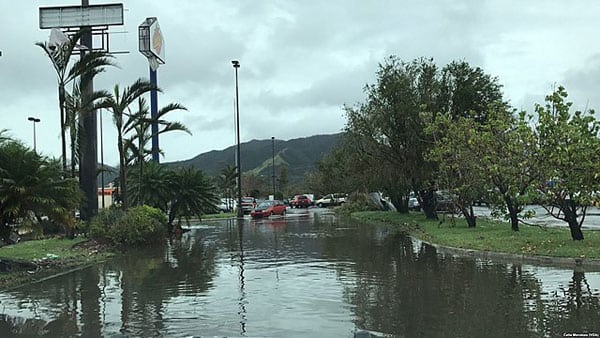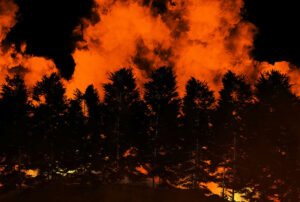
August 28, 2018; Washington Post and Wall Street Journal
A Puerto Rico government–commissioned report, led by a team from George Washington University (GWU), reports that Hurricane Maria led to 2,975 excess deaths in the six months after the storm made landfall. The 2,975 figure is an estimate; the report says with 95-percent confidence that the true number lies between 2,658 and 3,290 excess storm-related deaths. This, notes Adrian Campo-Flores in the Wall Street Journal, works out to a mortality rate that is 22 percent higher than the standard Puerto Rico mortality rate for that period.
As Campo-Flores reports, Governor Ricardo Rosselló indicated that “he would sign an executive order updating the official death toll, with the caveat that the number was an estimate.” Rosselló acknowledged that the island’s government had fallen short in its response to the storm, “Yes, I made mistakes. Yes, in hindsight, things could have been handled differently. My commitment as governor is accepting that criticism, but also building on it,” Rosselló said.
Initially, the Puerto Rico government estimated that 64 died. But thousands more died in its aftermath. As NPQ noted this spring, storm-related mortality occurs “not simply through direct storm-related trauma (e.g., a roof falling on one’s head), but by exacerbating pre-existing health conditions.”
Deaths, according to Arelis Hernández, Samantha Schmidt, and Joel Achenbach of the Washington Post, “were spread across 18 municipalities, with metropolitan San Juan, western Puerto Rico and the island of Vieques experiencing some of the highest increases in mortality.” Their reported mortality data is below:
| Sept.-Oct. | Nov.-Dec. | Jan-Feb. | Total | |
| Actual deaths (“observed”) | 5,921 | 5,454 | 5,233 | 16,608 |
| Normal (“predicted”) | 4,650 | 4,627 | 4,356 | 13,633 |
| Difference | 1,271 | 827 | 877 | 2,975 |
| Ratio | 1.27 | 1.18 | 1.20 | 1.22 |
The report itself also highlights that the poor suffered the most. Indeed, mortality rates for those at upper- and middle-income levels in Puerto Rico largely returned to pre-storm levels within six months of the storm, but this was not at all the case for low-income Puerto Ricans.
Sign up for our free newsletters
Subscribe to NPQ's newsletters to have our top stories delivered directly to your inbox.
By signing up, you agree to our privacy policy and terms of use, and to receive messages from NPQ and our partners.
As the report details, “Risk of death was higher and persistent until the end of the study period for populations living in low socioeconomic development municipalities (a ratio of 1.5 at the end of February 2018).” In other words, for low-income Puerto Ricans, the death rate was still 50 percent higher than normal six months after the storm. The report also noted that six months after the storm mortality risk was concentrated among men who were 65 and older; all other demographic groups had reached the baseline mortality risk level by February.
The report’s death toll estimate may still prove to be low. This is because the GWU team looked at six months of data assuming that “the elevated mortality rate would return to a normal level” by the end of six months. But that is not the case. Hernández and her colleagues note that “Nearly 900 excess deaths were reported in January and February of this year.” The GWU report, Hernández and her colleagues add, has another limitation, namely that, “It does not specify how people died. It is a statistical study based on death records and expected mortality rates. The researchers said they hope to conduct a more detailed investigation in the future.”
Lynn Goldman, dean of the Milken Institute School of Public Health at GWU, tells the Post, “We can come up with a hundred different hypotheses,” lack of electricity being one of them. “What we don’t have is the ability today to tell you these are the factors that caused this.”
The report mainly focuses on estimating the death toll and identifying ways to provide better estimates in the future. But, of course, better communications would surely have reduced the storm’s death toll considerably. One simple example from the report:
Key leaders cited radio as a relatively reliable and credible channel of post-hurricane communication; however, this channel was reported as utilized only to a very limited extent for disseminating health-related prevention messages and information. Respondents highlighted perceived inadequacies of health-risk communication messaging, even after telecommunications services were restored.
As NPQ reported last month, full rebuilding of Puerto Rico’s infrastructure is expected to take at least a decade. A draft government report had estimated rebuilding expenses over 10 years would total $124.6 billion. As Caribbean Business reports, the final government submission to Congress in August upped that estimate to $139 billion. This includes $3.2 billion for communications investments, such as those that the GWU report recommends. Additional recommendations include “$33 billion for Housing; $30 billion for Water Systems; $26 billion for Energy Systems; $15 billion for Education; $8.4 billion for Transportation; $6.3 billion for Health; $6.3 billion for Economy; $5.8 billion for Public Buildings; $3.9 billion for Environment…$590 million for Planning; and $190 million for Municipalities.” To date, federal aid to Puerto Rico, Campo-Flores reports, has been $13.7 billion—one tenth of that amount.—Steve Dubb












